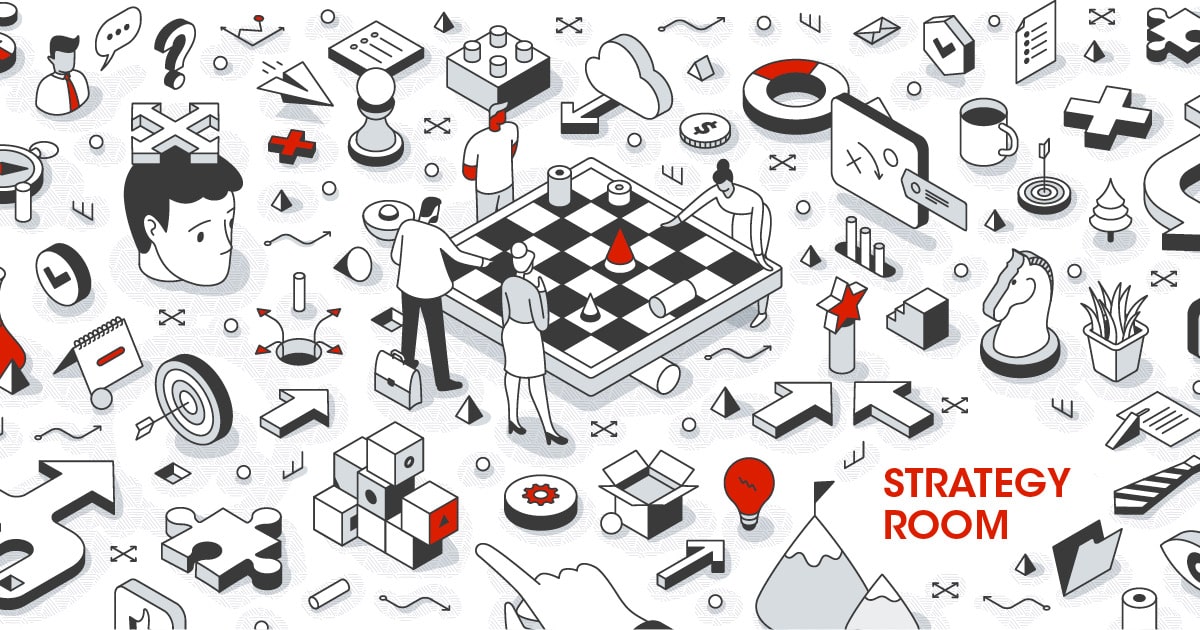Space for strategy implementation

How to use visualization in the Strategy Room
An article from Thomas Biasi, partner and trainer of the CA controller akademie
I want to tell you about my experience with Federico, the founder and Chairman of the Supervisory Board of a medium-sized company in the furnishings industry based in Bologna, Italy: He and his team spent several months working on a strategy project. Finally, they formally adopted their strategy paper, in which they decided on some significant changes. Everyone was very proud and happy about the challenge they had mastered. Federico then went back to his usual work, as did his team. And the strategy paper was forgotten. When I asked about the next steps, I received a shrug. An isolated case?
According to CA’s own survey conducted as part of its 2022 Business Planning Conference, 42% of attendees said their strategy received little attention and lacked commitment or follow-through. Note: the participants were all interested in planning and strategy. What does it look like in organizations that are not as close to the topic of strategy and where no one promotes the topic? Where little attention is paid to strategy work? My personal experience clearly shows that the percentage of failed strategy projects is actually much higher. What is the reason for this, and above all, what can be learned from it? And why should controllers hold the reins on this issue?
Let’s expand the process of strategy work a bit to get an overview. Three phases can generally be roughly distinguished in the context of strategy work:
- The phase of strategic analysis, generation of ideas and knowledge
- The phase of decision-making in the context of a strategic retreat
- The implementation phase
I would like to focus on the implementation phase at this point. As is so often the case, it is about the missing first step in the implementation of an idea or a wish. It is the decision that finally lets you climb a mountain or successfully advance a bu ness idea. The first step for a successful strategy implementation must be taken by people, not methods! It is a question of the leadership that wants a strategy project from the team. It is the leadership that successfully gets involved and contributes. It is not primarily a question of using tools such as Objectives and Key Results (OKR), Lean Project Portfolio Management (PPM), Balanced Scorecard (BSC), Strategy Maps, Management by Objectives (MbO) or other methods. In successful strategy projects, it is the executives who are involved not only in developing the strategy, but also in implementing it. Nevertheless, many companies rush into a “new” method in the hope of achieving quick and sustainable strategic successes.
There are, of course, many ways to involve a management team in a strategy project. But one approach has proven to be very successful in practice. In our consulting projects, we like to use an easy-to-implement concept: the strategy room. In the example with Federico from Bologna, things went the same way: a methodical path had been taken, but without paying attention to the crucial work of strategy implementation. In several meeting loops, we then structured the way forward together with the management team and the head of controlling. In the end, we decided on a Strategy Room, which I would like to introduce to you at this point.
“The first step for a successful strategy implementation must be taken by people, not methods!”
The Strategy Room is a workspace that visualizes strategic decisions on the walls. It is a room that is used to communicate the strategy across hierarchies and departments and that subsequently serves a strategic plan-actual comparison. The following 3 aspects are of central importance:
- Visualization: all agreed-upon goals, initiatives, projects, or investments are printed out in A3 format and hung on the walls. This has the advantage of being able to work on the possibly excessive number of goals again and to prioritize them if necessary. This prioritization of goals is a management task and is carried out based on agreed criteria. These include, for example, the contribution to achieving the vision and mission, the contribution to strengthening competitive advantages, and so on. The discussion takes place in the Strategy Room, with the printed target images always in view.
- Communication: the agreed-upon strategic goals are communicated to the organization. In a large organization this is to the next hierarchical level, which then informs the next level in the Strategy Room about the goals. This is a very important moment and crucial for success: Is the respective “upper” level able to communicate the goals in a credible and understandable way with a clear target picture? Can the plenum take the time to reflect on the goals, ask questions and derive consequences for their own work? Another communicative benefit results from holding as many meetings as possible in the room. We particularly recommend this for operational budget meetings or monthly meetings. This way, there is always visual contact with the strategic goals and reference can be made to them. Are the operational measures sufficient to achieve the strategic goals?
- Plan-actual-comparison: The decided strategic goals are formulated using the SMART method (especially measurable and time-bound). This allows reporting with simple methods. For example, a strategic goal only receives a visible large green dot when it is achieved. All other goals remain red for that long. A clear sign: when the usual periodic management meetings are then held in the room, the degree of achievement is always visible.
Even if you are only at the start of your strategic journey and have only formulated a few strategic goals: Hang them up in the room! You will be surprised and pleased at the impact they will have on your meetings. It is a very simple and inexpensive method to ensure better strategy communication. Because: out of sight, out of mind! What use is the best strategy, that lies secretly in a safe and which nobody knows? Controlling can make a valuable and significant contribution to the development of strategic planning culture and thinking. A check list of questions can help with this.
Questions for controlling
- What strategic experience do the managers bring with them?
- How important is the independent development of a strategy?
- What is the prevailing culture of strategic planning and action?
- How well do strategic goals cascade to the next hierarchical level?
- How important is a strategic plan-actual comparison?
- Can you reserve a suitable room as a strategy room?
- How can you use a strong visualization to help “beginners” in particular?
Some of these questions are discussed in the current issue of Controller Magazine. If you would like to discuss this with me, you can reach me at t.biasi@ca-akademie.de.
Author: Thomas Biasi, partner and trainer, CA Akademie AG



